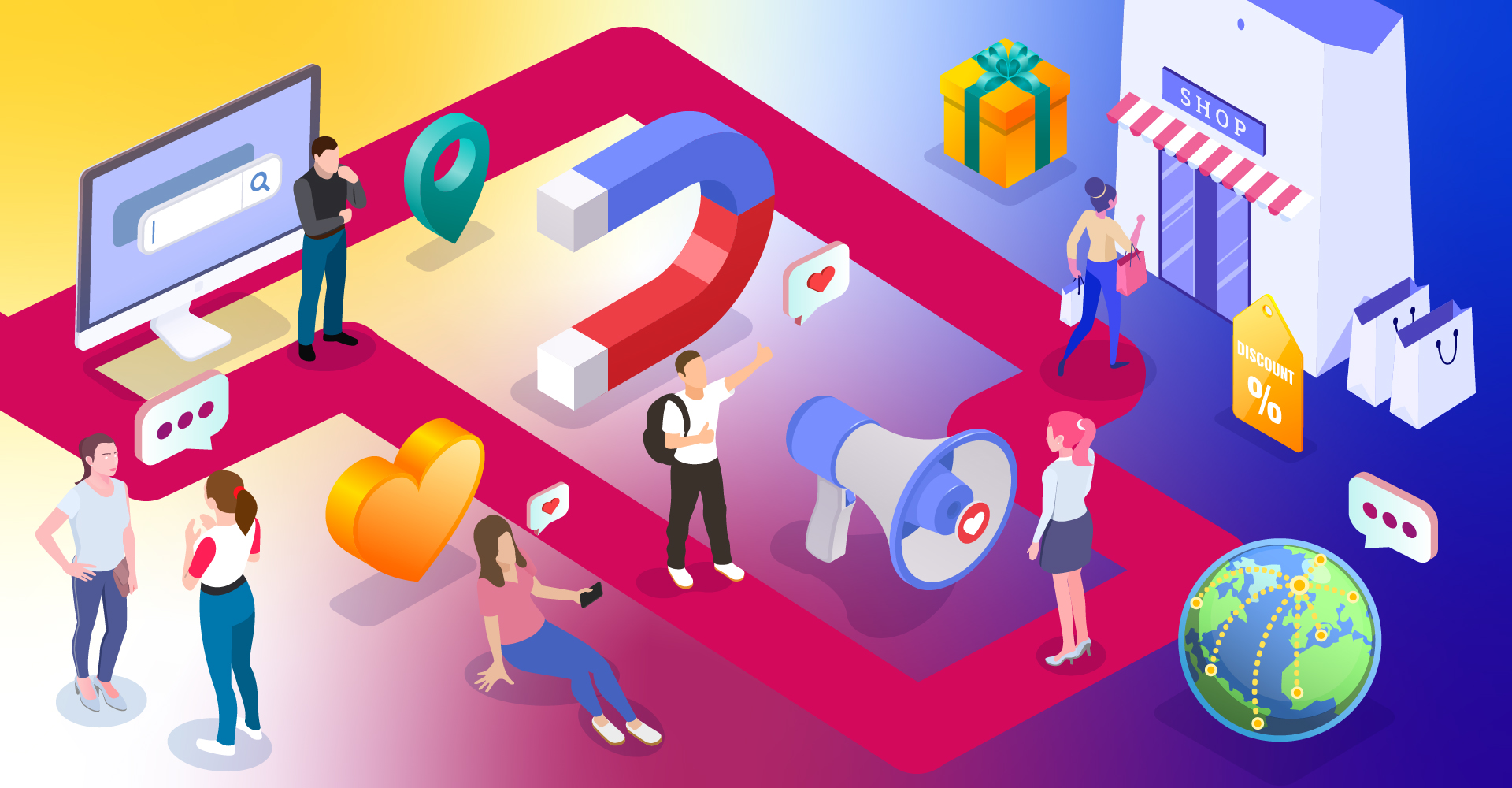Customer journey mapping helps you to create content based on your customers’ needs to increase customer retention and achieve higher conversions. We show you how to guide users from first contact with your company to purchase and turn them into fans and promoters in the end. This article will help you understand the needs of your users and to achieve more clicks and a higher engagement on your social media profiles through specific marketing efforts. In this article, you will learn everything you need to know about the customer journey in general, including 6 steps to map it and align your marketing strategy accordingly.
Comprehend Customer Journey
The customer journey will allow you to understand how your target group acts, from the first contact to the defined action (e.g. purchase). Understanding the relationship, you will be able to set up the structure of the journey in different touchpoints. Touchpoints are all steps in which your customers interact with you through your online presence. From gaining awareness of your brand via social media, through receiving a “thank you” e-mail for purchasing. Knowing your customer journey will help you align your marketing strategy and adapt it to the needs of your customers. This is an efficient way to increase retention and generate higher conversions.
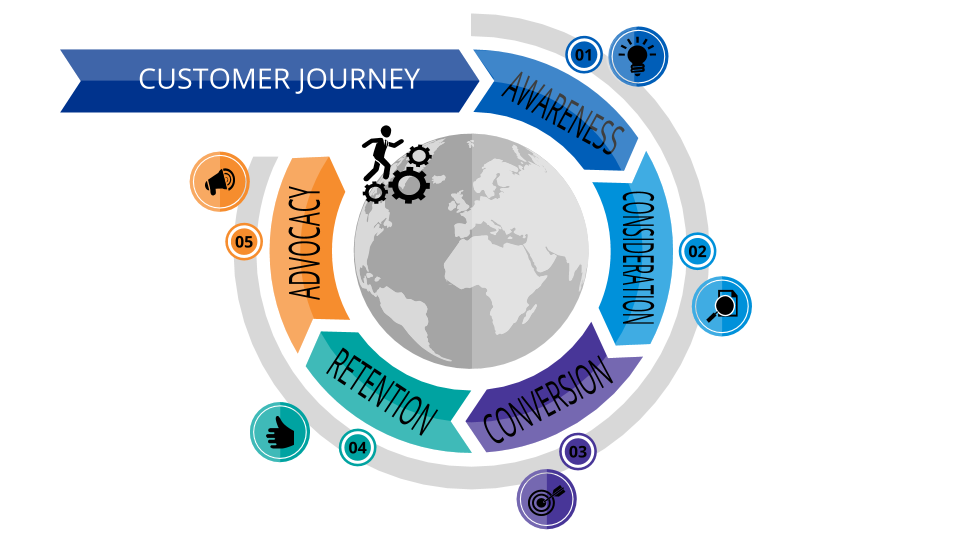
5 Phases of the Customer Journey
The 5 phases of the customer journey create a clear structure. Users have different needs in each phase. The phases will help you to align specific marketing activities with potential customers and convince them at the right point. In the following, we will show you which online activities will reach the users’ successfully in each phase:
Phase 1: Awareness
The user recognizes a necessity or problem, becomes aware of your solution and develops an interest.
Brand awareness campaigns help you obtain attention of relevant users that have never heard of you before. Using PPC, Pay-Per-Click, campaigns such as Facebook advertisements can also be extremely effective in bringing your offers to your target audience. With the following social media ad, the digital music streaming service Spotify shows how to present their product to new users and increase awareness for their offer.

Phase 2: Consideration
The user thinks about your offer, collects more detailed information and starts making comparisons.
Many users research online before deciding for an offer. The amount of people using social media to get informed is constantly increasing. This is why you should use reviews and testimonials to convince your target group. Share them on your social media platforms.
Phase 3: Conversion
The user chooses your offer.
Create content with a clear call-to-actions that convinces your target audience to choose your offer. Using user-generated content on your social media platforms or your own website works great. Using clear CTAs, car rental company Sixt encourages customers to buy their product. Product-related content with clear CTAs is decisive for purchasing.
Phase 4: Retention
The user is satisfied and convinced to have made the right decision.
Even after the customer has chosen your offer, it is important to keep an eye on them. Creating an online community helps to build a long-term customer retention. It is very important to respond to comments, reactions and complaints on social networks. Increasing customer retention can help increase your reach and awareness.
Phase 5: Advocacy
The user is so satisfied that they begin promoting your product.
Social media can help build customer retention and maintain regular customer contact. It also makes it easier for your users to become promoters and share their own posts of your offer. This gives you the opportunity to share user-generated content and publish content from the community to increase customer retention and loyalty. Swedish fashion label Monki uses user-generated content and shares it almost daily on their Instagram profile. With over 13 thousand likes, posts like the following show how popular this type of content is among the community.
Sharing user-generated content also helps you increase your engagement.
Optimize your content planning
Use our editorial plan and start with efficient content planning now. Check our content checklist here https://blog.fanpagekarma.com/2020/06/15/content-checklist-how-to-plan-content-efficiently/
Customer Journey Mapping
Ready to learn how your customer journey is structured and which marketing activities will optimize your online performance? We will show you how to use customer journey mapping to convince your users and turn them into loyal fans in the end. The following six steps will help you to set up your own customer journey map.
1. Gather Information
First, you need to gather information to track the customer journey as realistically as possible. Tracking tools, such as Google Analytics, can be used to collect data on user behavior. With tracking, you can find out which pages are visited most often, where users come to your site from or whether they subscribe to a newsletter. You can also use surveys to collect information about users needs, thoughts and perceptions. A solid database is essential for the following steps and will flow into the entire process. You can use CRM software to analyze and track your customer data.
2. Create Buyer Personas
A customer journey always builds on a buyer persona. Personas are fictitious characters that represent a specific target group. To get a clear picture of your users, you should consider basic aspects such as age, life circumstances, profession and marital status. In addition, information about personal values, goals and possible objections will help you to create a persona. Like this, you will find out more about your users and their decisions, feelings and ways of thinking. Now you are able to create user-specific content and campaigns to increase click rates and engagement.
3. Determine Touchpoints and Channels
Channels and touchpoints will give your customer journey an additional structure. Touchpoints are specific interactions between users and your company. These include visiting a social media profile or reacting to search ads, such as Google Ads. You can categorize touchpoints into direct touchpoints between potential customers and your company (advertisements, social media channels, websites, online shops, etc.) and indirect touchpoints where people inform themselves about your offer (blogs, forums, rating portals, etc.). Below you will find a possible customer journey with focus on online touchpoints:
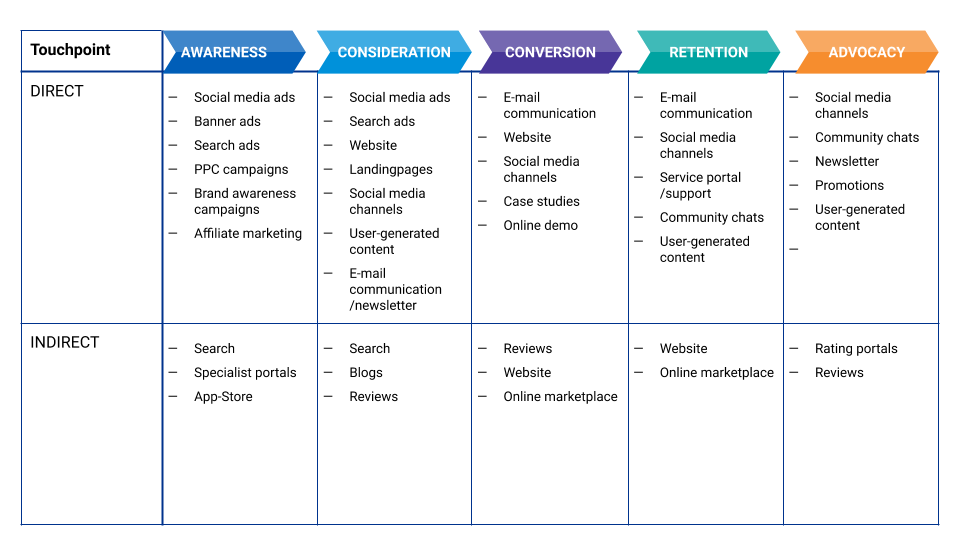
4. Identify Needs, Emotions and Problems of Your Audience
To increase customer satisfaction it will help to learn more about the needs, emotions and problems of your target group. Try to look through the eyes of your persona(s) at each touchpoint and ask yourself the following questions. How does the persona feel at the touchpoint? Is the experience positive, negative or neutral? Does the persona receive the relevant information in each phase? If not, what is missing? The information you will get about the persona will help you to make assumptions about behavior and needs. This will help you to visualize the customer journey. An example might look like this:
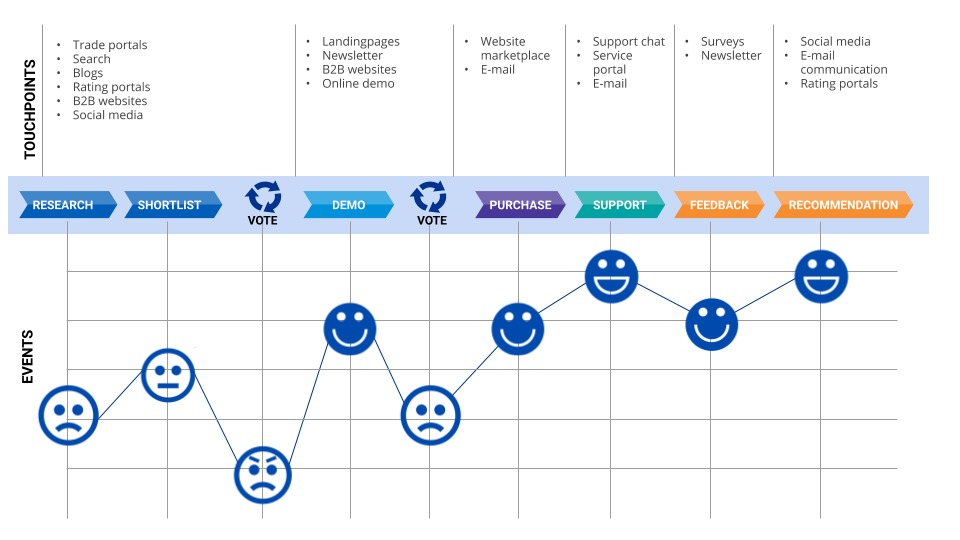
You will get a clear overview of all emotions that users might have. You can remove negative touchpoints or adjust them so that negative emotions will no longer be triggered. For example, there might be non-relevant content on social media not aiming at users’ interests. This will generate fewer clicks and less engagement. If you want to convince your users to purchase again or win them as promoters, the emotions should get more and more positive during the customer journey.
5. Create Customer Journey Map
In the end, you need to add descriptions of the different steps to your map. A step describes any experience a persona has related to your product. The descriptions will help you to create a clear map and finally describe a customer related journey. The following graphic shows how a customer journey map can look like:
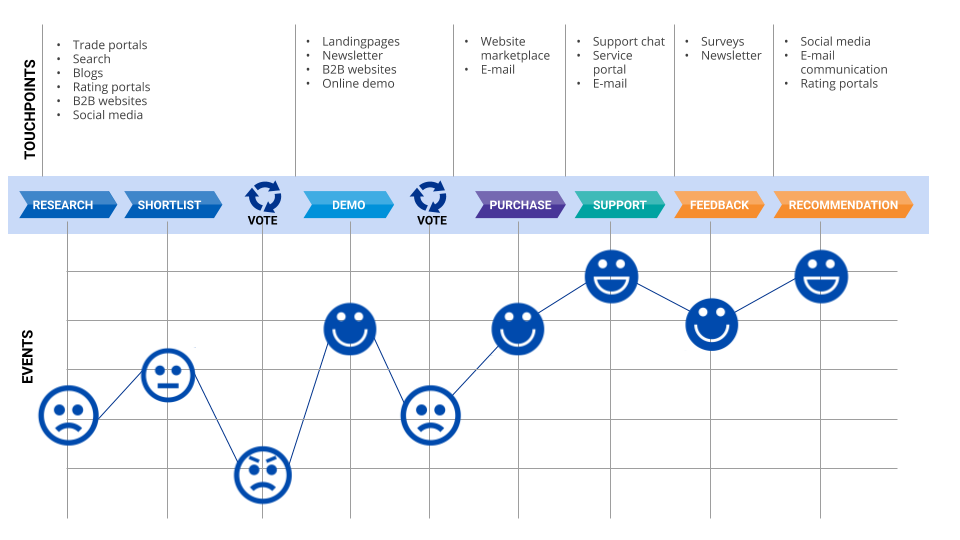

6. Testing and Readjustment
Take the customer journey yourself and try to look through the eyes of your buyer persona as you do it. The self-experiment will help you to understand the journey better and to check it for plausibility. Negative experiences or missing touchpoints can help to make the necessary adjustments and improve your marketing strategy. Maybe you need a more convincing call-to-action to convert more users at a certain touchpoint.
Conclusion
Customer journey mapping will help you to visualize your customers’ experience across all channels and touchpoints. You will learn to identify weaknesses in your customer journey and to implement specific actions to optimize your social media strategy. This way you will guide your users successfully through the buying process and finally turn them into loyal fans and promoters.
Optimize and automate your social media management
If you would like to track your success, automate your posting and manage all your social media pages over one tool, then try Fanpage Karma for free.


